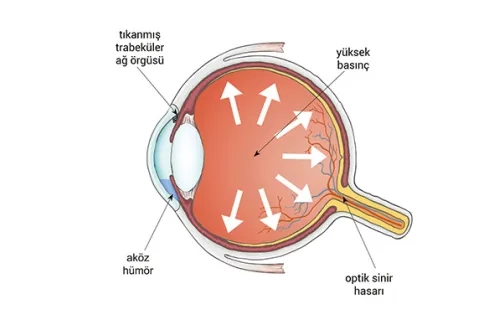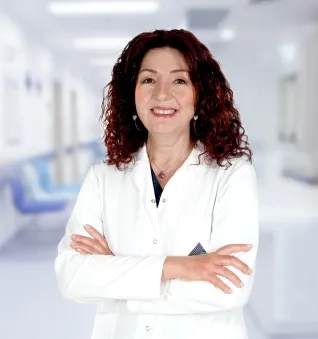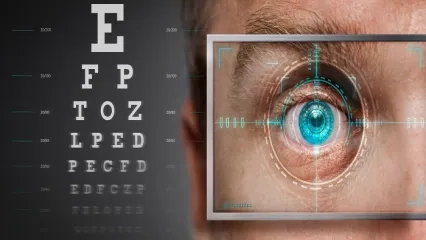Alo Yeditepe
Alo Yeditepe
Glaucoma
What is Glaucoma?
Glaucoma is a disease that occurs as a result of the pressure created by the fluid produced in the eye leaving the eye, high enough to damage the optic nerve.
What Are the Causes of Glaucoma?
Normally, there is a constantly produced fluid in the eye to feed the intraocular tissues, and after this fluid completes its function, it leaves the eye through microscopic channels. Glaucoma occurs as a result of insufficient drainage of the fluid due to the formation of structural obstruction in the channels that discharge the intraocular fluid, and consequently the increase in fluid pressure in the eye. Rising intraocular pressure causes the death of optic nerve cells by compressing and damaging the optic nerve. Permanent vision loss occurs when optic nerve cells die.
What Are the Symptoms of Glaucoma?
Glaucoma, which usually occurs over the age of 40, progresses very insidiously over the years. During this period, it does not give any symptoms of the disease. Early diagnosis is important in glaucoma, as there is no return after vision loss occurs. An increase in intraocular pressure detected during normal eye examination may be the first sign of the disease. Regular eye examinations are the best way to diagnose and treat glaucoma early.
Narrow-angle glaucoma is another type of glaucoma that occurs suddenly in advanced ages, although it is rarer. It creates a picture characterized by severe eye pain, decreased vision, redness of the eye, nausea, and vomiting. It requires urgent treatment. In addition, glaucoma observed in infancy and childhood, eye enlargement, watering, and sensitivity to light are observed.
Factors that increase the risk of glaucoma are listed as follows;
- Advancing age
- Family history of glaucoma (Genetic predisposition)
- Smoking
- High-low blood pressure
- Myopia, hyperopia
- Long-term cortisone therapy
- Eye injuries
- Migraine
It is extremely important for people with these characteristics to have eye examinations for glaucoma.
How Is Glaucoma Diagnosed?
- Glaucoma is diagnosed with a careful eye examination.
- Intraocular pressure is measured with an instrument called tonometry.
- Loss of the optic nerve (increased pitting) by performing a fundus examination
- With visual field examination, it is investigated whether there is damage to peripheral vision.
- Detailed loss analysis can be performed by applying advanced methods that examine the optic nerve and nerve fiber layer tomographically.
How Is Glaucoma Treated?
Damage to the eye caused by glaucoma is irreversible. Eye drops, laser surgery, and surgical interventions are applied to prevent further loss. In some cases, oral medications are also used.
In order to prevent vision loss in all types of glaucoma, regular check-ups are very important. Since glaucoma can progress insidiously, it may be necessary to make adjustments in the treatment from time to time.
Can Glaucoma Be Cured?
Glaucoma cannot be completely cured and eliminated after diagnosis, but in many cases, it can be kept under control with appropriate treatment and the progression of vision loss can be prevented.
Medication Treatment in Glaucoma Disease
Glaucoma is primarily treated with various medications that lower intraocular pressure. These medications are usually in the form of eye drops. It is mandatory to use eye drops every day. Depending on the recommended medication treatment, it is necessary to use eye drops or drops at regular intervals once or several times a day. During the treatment period, the doctor's recommendations should be followed.
Since glaucoma is a progressive disease, the eye drops may be changed by the ophthalmologist, or it may be necessary to add other eye drops to the treatment. The first reason for making these changes is to keep the intraocular pressure under control and to protect the visual field. In addition, the possible side effects of the drops used may necessitate these changes. While glaucoma medications protect vision, they can also cause side effects. Therefore, if you experience any side effects, be sure to inform your ophthalmologist about it.
Side effects that some eye drops can cause include:
- Burning or stinging sensation,
- Redness in the eyes or on the skin around the eyes,
- Changes in pulse strength or number,
- Change in your energy level,
- Change in your breathing (especially in patients with asthma and emphysema),
- Dry mouth,
- Change in the sense of taste,
- Headache,
- Blurred vision,
- Change in eye color,
- Elongation in eyelashes.
All medications have a risk of side effects or interactions with other medications. For this reason, it is very important to make a list of all the medications you use regularly and show this list to your doctor each time you go for a checkup.
Laser Treatment in Glaucoma Disease
In cases where medical treatment cannot be applied or is insufficient, laser or surgical interventions can be applied. The aim of these treatments is not to increase vision but to protect the patient's remaining vision. In the narrow-angle type that occurs with the crisis, the treatment is very urgent and it may be necessary to first open a hole in the iris tissue with a laser. Laser surgery may be recommended for different types of glaucoma.
In open-angle glaucoma, the microscopic canal system is treated directly. The laser is used to control intraocular pressure by causing changes in the canal system (trabeculoplasty). In angle-closure glaucoma, a hole is created in the iris tissue (iridotomy) with a laser, and the flow of aqueous humor fluid through the canal system is tried to be corrected.
Surgical Treatment in Glaucoma Disease
When surgical intervention is considered for the treatment of glaucoma, a new channel is created for the outflow of the fluid produced with very thin surgical instruments (trabeculectomy). When your ophthalmologist thinks that additional damage to the optic nerve must be prevented, he or she may recommend surgical treatment.
Like laser surgery, other surgical procedures are procedures that do not require hospitalization. Treatment of congenital glaucoma is mainly surgery. Some patients may require more than one surgical intervention.
Important Rules for Glaucoma Patients
- Use your medication as recommended by your doctor and take care to take your medication at the same time every day. In this way, you will remember your eye drops more easily and make them more effective.
- Be sure to inform your doctor of any side effects that affect your daily life.
- Follow your doctor's scheduled checkup appointments. Remember, your disease can only be successfully treated when you are under the regular control of your doctor.
- When you see another doctor other than your ophthalmologist, let him/her know that you have glaucoma.
- Warn all members of your family to have regular eye examinations, as glaucoma can be hereditary.
Ages 20-29: Anyone with a family history of glaucoma should have an eye examination every 3-4 years.
Ages 30-39: Anyone with a family history of glaucoma should have an eye examination every 2-3 years.
Ages 40-64: Everyone should have an eye examination every 2 years.
Age 65 and over: Everyone should have an eye examination once a year.
What Is Your Role in Treatment?
Glaucoma treatment is a situation that requires teamwork between the patient and his/her doctor. Your ophthalmologist may recommend treatment for glaucoma, but remember that you must apply them and this will affect the success of the treatment. When you start receiving treatment for glaucoma, your ophthalmologist will want to see you more often. On average, you should expect to see your ophthalmologist every 3 or 4 months. This will vary according to your treatment needs.
This content was prepared by Yeditepe University Hospitals Medical Editorial Board.
”
See Also
- Damages of Fake Sunglasses
- What is Cataract? Symptoms and Treatment
- Do not Risk Going Blind While Trying to Have Colored Eyes
- Get Your Child's Eye Examination Done Before They Go to School!
- Watch Out Blue Light Emitted By Devices For The Health of Your Eyes
- Pollen is Now Seen Outside of Seasonal Changes
- A Common But Little-Known Disease: Retinopathy of Prematurity (ROP)
- Pay Attention to the Flashing Light in the Eye!
- Medication Administration to the Eye
- Thyroid-Related Eye Diseases
- If You Have Diabetes, Consult An Ophthalmologist At Least Once A Year.
- It was Told that She could Lose Both Eyes, but She Recovered with an Operation
- Untreated Strabismus Can Cause Vision Problems!
- The Danger to the World: MYOPIA
- Eyelid Diseases
- Is Strabismus Genetic?
- One in 20 Newborns Have Tear Duct Obstruction
- Are Flies Flying Before Your Eyes?
- 7 Tips to Protect Your Eye Health
- Allergic Conjunctivitis (Eye Allergy)
- Eye Problems Increase as Children's Digital Screen Time Extends
Alo Yeditepe








